Related Research Articles
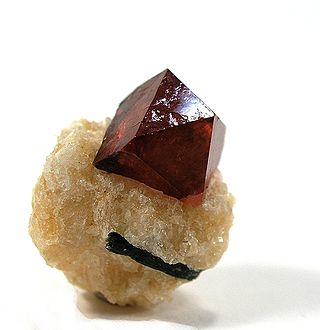
Zircon is a mineral belonging to the group of nesosilicates and is a source of the metal zirconium. Its chemical name is zirconium(IV) silicate, and its corresponding chemical formula is ZrSiO4. An empirical formula showing some of the range of substitution in zircon is (Zr1–y, REEy)(SiO4)1–x(OH)4x–y. Zircon precipitates from silicate melts and has relatively high concentrations of high field strength incompatible elements. For example, hafnium is almost always present in quantities ranging from 1 to 4%. The crystal structure of zircon is tetragonal crystal system. The natural color of zircon varies between colorless, yellow-golden, red, brown, blue, and green.

The Nördlinger Ries is an impact crater and large circular depression in western Bavaria and eastern Baden-Württemberg. It is located north of the Danube in the district of Donau-Ries. The city of Nördlingen is located within the depression, about 6 kilometres (3.7 mi) south-west of its centre.

Manicouagan Reservoir is an annular lake in central Quebec, Canada, covering an area of 1,942 km2 (750 sq mi). The lake island in its centre is known as René-Levasseur Island, and its highest point is Mount Babel. The structure was created 214 (±1) million years ago, in the Late Triassic, by the impact of a meteorite 5 km (3 mi) in diameter. The lake and island are clearly seen from space and are sometimes called the "eye of Quebec". The lake has a volume of 137.9 km3 (33.1 cu mi).

Coesite is a form (polymorph) of silicon dioxide (SiO2) that is formed when very high pressure (2–3 gigapascals), and moderately high temperature (700 °C, 1,300 °F), are applied to quartz. Coesite was first synthesized by Loring Coes, Jr., a chemist at the Norton Company, in 1953.

Impactite is rock created or modified by one or more impacts of a meteorite. Impactites are considered metamorphic rock, because their source materials were modified by the heat and pressure of the impact. On Earth, impactites consist primarily of modified terrestrial material, sometimes with pieces of the original meteorite.
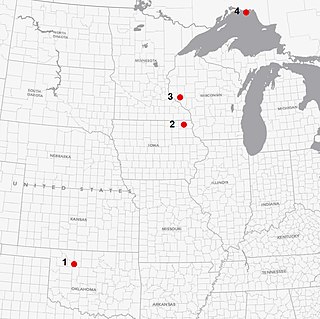
The Rock Elm Disturbance is an impact crater in Pierce County, Wisconsin, United States, roughly 40 kilometres (25 mi) southwest of Menomonie. The disturbance is named for Rock Elm, Wisconsin, a nearby town.

The Vredefort impact structure is the largest verified impact structure on Earth. The crater, which has since been eroded away, has been estimated at 170–300 kilometres (110–190 mi) across when it was formed. The remaining structure, comprising the deformed underlying bedrock, is located in present-day Free State province of South Africa. It is named after the town of Vredefort, which is near its centre. The structure's central uplift is known as the Vredefort Dome. The impact structure was formed during the Paleoproterozoic Era, 2.023 billion years ago. It is the second-oldest known impact structure on Earth, after Yarrabubba.

Woodleigh is a large meteorite impact structure (astrobleme) in Western Australia, centred on Woodleigh Station east of Shark Bay, Gascoyne region. A team of four scientists at the Geological Survey of Western Australia and the Australian National University, led by Arthur J. Mory, announced the discovery in the 15 April 2000 issue of Earth and Planetary Science Letters.
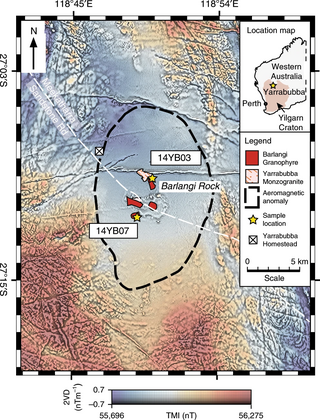
The Yarrabubba impact structure is the eroded remnant of an impact crater, situated in the northern Yilgarn Craton near Yarrabubba Station between the towns of Sandstone and Meekatharra, Mid West Western Australia. With an age of 2.229 billion years, it is the oldest known impact structure on Earth.
Meteoritics is the science that deals with meteors, meteorites, and meteoroids. It is closely connected to cosmochemistry, mineralogy and geochemistry. A specialist who studies meteoritics is known as a meteoriticist.

Libyan desert glass or Great Sand Sea glass is an impactite, made mostly of lechatelierite, found in areas in the eastern Sahara, in the deserts of eastern Libya and western Egypt. Fragments of desert glass can be found over areas of tens of square kilometers.

Pseudotachylyte is an extremely fine-grained to glassy, dark, cohesive rock occurring as veins that form through frictional melting and subsequent quenching during earthquakes, large-scale landslides, and impacts events. Chemical composition of pseudotachylyte generally reflects the local bulk chemistry, though may skew to slightly more mafic compositions due to the preferential incorporation of hydrous and ferro-magnesian minerals into the melt phase.
The term iridium anomaly commonly refers to an unusual abundance of the chemical element iridium in a layer of rock strata at the Cretaceous–Paleogene (K–Pg) boundary. The unusually high concentration of a rare metal like iridium is often taken as evidence for an extraterrestrial impact event.

Wadsleyite is an orthorhombic mineral with the formula β-(Mg,Fe)2SiO4. It was first found in nature in the Peace River meteorite from Alberta, Canada. It is formed by a phase transformation from olivine (α-(Mg,Fe)2SiO4) under increasing pressure and eventually transforms into spinel-structured ringwoodite (γ-(Mg,Fe)2SiO4) as pressure increases further. The structure can take up a limited amount of other bivalent cations instead of magnesium, but contrary to the α and γ structures, a β structure with the sum formula Fe2SiO4 is not thermodynamically stable. Its cell parameters are approximately a = 5.7 Å, b = 11.71 Å and c = 8.24 Å.
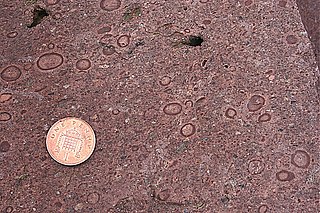
The Stac Fada Member is a distinctive layer towards the top of the Mesoproterozoic Bay of Stoer Formation, part of the Stoer Group in northwest Scotland. This rock unit is generally 10 to 15 metres thick and is made of sandstone that contains accretionary lapilli and many dark green glassy fragments of mafic composition.
Shock metamorphism or impact metamorphism describes the effects of shock-wave related deformation and heating during impact events.
Dhala crater is an impact structure formed by an asteroid impact. It is situated near Bhonti village in Pichhore block of Shivpuri district of Madhya Pradesh state in India. It is the largest impact structure in India, and between the Mediterranean and Southeast Asia. The diameter of the structure is estimated at 3 kilometres (1.9 mi), while other sources estimate its diameter to be 11 km diameter. It is the second such structure found in India, after Lonar lake.
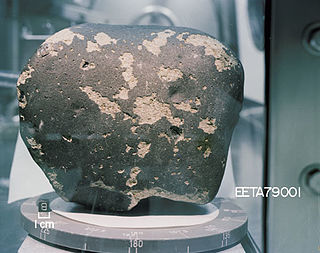
Elephant Moraine 79001, also known as EETA 79001, is a Martian meteorite. It was found in Elephant Moraine, in the Antarctic during the 1979–1980 collecting season.

Lunar Sample 14321, better known as "Big Bertha", is a lunar sample containing an embedded Earth-origin meteorite collected on the 1971 Apollo 14 mission. It was found in the Fra Mauro region of the Moon. Big Bertha is the first discovered meteorite from Earth, and the embedded meteorite portion is the oldest known Earth rock. At 8.998 kg (19.84 lb), this breccia rock is the third largest Moon sample returned during the Apollo program, behind Big Muley and Great Scott.

Ludovic Ferrière is a geologist and curator of the meteorite collection and of the impactite collection at the Natural History Museum, Vienna, Austria. He is known for his research on meteorite impact craters.
References
- ↑ Warr, L.N. (2021). "IMA–CNMNC approved mineral symbols". Mineralogical Magazine. 85 (3): 291–320. Bibcode:2021MinM...85..291W. doi: 10.1180/mgm.2021.43 . S2CID 235729616.
- ↑ "Reidite". mindat.org. Hudson Institute of Mineralogy. Retrieved 18 March 2015.
- ↑ "Reidite Mineral Data". Webmineral.com. Retrieved 18 March 2015.
- ↑ Discovery of reidite, one of the rarest minerals on Earth, may reveal Australia's biggest crater ABC News , 16 October 2018. Retrieved 17 October 2018.
- ↑ Oskin, Becky (3 November 2014). "Rare Mineral Discovered in Ancient Meteorite Impact Crater". Livescience.com. Livescience. Retrieved 24 March 2015.
- ↑ Li, Shan-Shan; Keerthy, S.; Santosh, M.; Singh, S.P.; Deering, C.D.; Satyanarayanan, M.; Praveen, M.N.; Aneeshkumar, V.; Indu, G.K. (February 2018). "Anatomy of impactites and shocked zircon grains from Dhala reveals Paleoproterozoic meteorite impact in the Archean basement rocks of Central India". Gondwana Research. 54: 81–101. Bibcode:2018GondR..54...81L. doi:10.1016/j.gr.2017.10.006.
- ↑ Xing, Weifan; Lin, Yangting; Zhang, Chi; Zhang, Mingming; Hu, Sen; Hofmann, Beda A.; Sekine, Toshimori; Xiao, Long; Gu, Lixin (2020-11-16). "Discovery of Reidite in the Lunar Meteorite Sayh al Uhaymir 169". Geophysical Research Letters. 47 (21). Bibcode:2020GeoRL..4789583X. doi:10.1029/2020GL089583. ISSN 0094-8276. S2CID 226337486.
- ↑ Reid, A. F.; Ringwood, A. E. (1969-06-01). "Newly observed high pressure transformations in Mn3O4, CaAl2O4, and ZrSiO4". Earth and Planetary Science Letters. 6 (3): 205–208. doi:10.1016/0012-821X(69)90091-0. ISSN 0012-821X.
- ↑ Glass, B.P.; Liu, Shaobin (2001-04-01). "Discovery of high-pressure ZrSiO4 polymorph in naturally occurring shock-metamorphosed zircons". Geology. 29 (4): 371–373. doi:10.1130/0091-7613(2001)029<0371:DOHPZP>2.0.CO;2. ISSN 0091-7613.
- ↑ Timms, Nicholas E.; Erickson, Timmons M.; Pearce, Mark A.; Cavosie, Aaron J.; Schmieder, Martin; Tohver, Eric; Reddy, Steven M.; Zanetti, Michael R.; Nemchin, Alexander A.; Wittmann, Axel (2017-02-01). "A pressure-temperature phase diagram for zircon at extreme conditions". Earth-Science Reviews. 165: 185–202. Bibcode:2017ESRv..165..185T. doi: 10.1016/j.earscirev.2016.12.008 . ISSN 0012-8252.
- ↑ Plan, Anders; Kenny, Gavin G.; Erickson, Timmons M.; Lindgren, Paula; Alwmark, Carl; Holm-Alwmark, Sanna; Lambert, Philippe; Scherstén, Anders; Söderlund, Ulf; Osinski, Gordon (October 2021). "Exceptional preservation of reidite in the Rochechouart impact structure, France: New insights into shock deformation and phase transition of zircon". Meteoritics & Planetary Science. 56 (10): 1795–1828. Bibcode:2021M&PS...56.1795P. doi: 10.1111/maps.13723 . ISSN 1086-9379. S2CID 238711754.
- ↑ Cavosie, Aaron J. (22 May 2019). "How we solved the mystery of Libyan desert glass". The Conversation. Retrieved 2019-10-12.